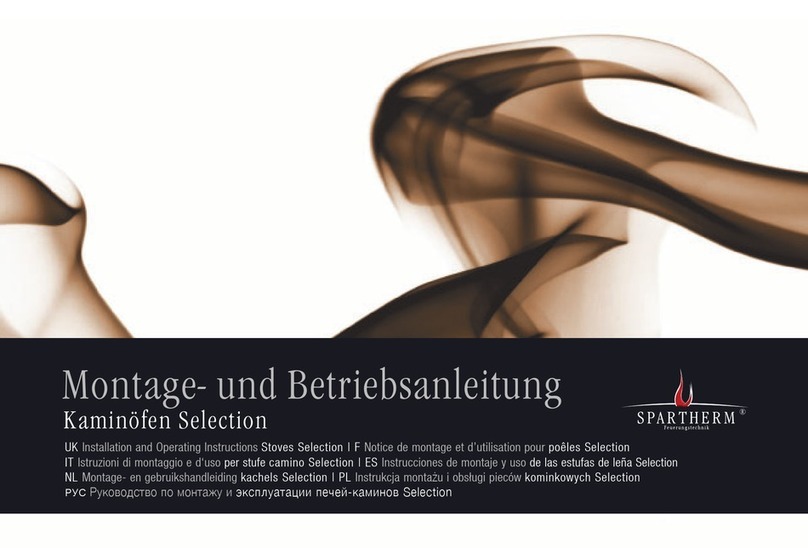GB 9
energy-saving reasons) it may be the case that an adequate fresh air supply
cannot be guaranteed. The stove draught may be adversely affected. This
can be detrimental to your health and also, in some cases, to your safety. If
necessary, an additional air supply should be provided by fitting an air inlet
near the stove or by fitting a combustion air intake pipe which connects
with the external air (see „2.2.2.2 Separate Combustion Air Supply“ on
page 9) or with a well ventilated room (not the room where the stove
is installed). In particular, it must always be ensured that the necessary
combustion air intakes remain operational when the fireplace is in use.
Operating a ventilating system at the same time, e.g. an extractor hood or
bathroom fan, in the same room or in an adjoining room can adversely affect
the operation of the stove (even causing smoke or flue gas to leak out into
the room, despite the firebox door being closed). Ventilating devices must
therefore not be operated at the same time as the stove unless suitable
measures are taken to maintain the air supply to the stove. („2.2.2.3 Room
Air Sealed“ on page 9).
2.2.2.2 SEPARATE COMBUSTION AIR SUPPLY
It is possible to provide the stove with a separate combustion air supply.
The separate combustion air connection can be connected to the rear of the
unit or to the bottom of the unit. The connecting piece is pre-assembled and
the cover panels should be opened up as necessary. If a pipe connection is
attached to the combustion air coupling, the combustion air can be drawn
into the stove from outside or from other rooms such as the basement. When
connecting the stove to a combustion air pipe, the requirements of TROL
(technical rules), DIN 18896, etc. should be observed and applied.
In particular, care should be taken that the dimensions of the pipes
are adequate. If using a swivel connector, a permanently flexible
connection must be made. The rotating action must not be restricted.
Combustion air intakes and pipes must not be obstructed or closed unless special
safety devices are fitted to ensure that the stove can only be operated when the
closing system is open. The cross-section must not be reduced by means of an
obstructor or grille. This measure is not necessary with balanced flue systems.
If the combustion air pipe has to be routed out of the building, a shut-off device
must be fitted. The position of the shut-off device must be obvious from the out-
side of the connecting pipe. In this design version the pipe should be insulated,
as condensate may form. Also, when fitting the pipe it should be ensured that
no water or other substances can enter the stove and that any condensate can
drain away. According to the relevant provisions, combustion air ducts that bridge
firewalls in buildings with more than two full storeys must be constructed such
that fire and smoke cannot spread to other storeys or fire lobbies. The national
and local fire precautions for the place of installation must be observed.
2.2.2.3 ROOM AIR SEALED
Room air sealed stoves have been developed for use in conjunction with home
ventilation systems for a negative pressure range of up to 8 Pa in the room where
the stove is installed and can be operated without any additional safety precau-
tions. In room air sealed operation, the air supply for combustion must be led into
the unit from an external source via airtight pipes, or via a balanced flue system.
The combustion air duct must be permanently sealed tightly to the combustion air
connecting piece (rear / side or bottom connection) on the stove.
When connecting a room air sealed stove to the combustion air pipe, the require-
ments of TROL (technical rules), DIN 18896, etc. should be observed and applied.
In particular, ensure the dimensions are adequate.
The national and local fire precautions for the place of installation must be
observed. Please ensure that the pipework is permanently leaktight.

































